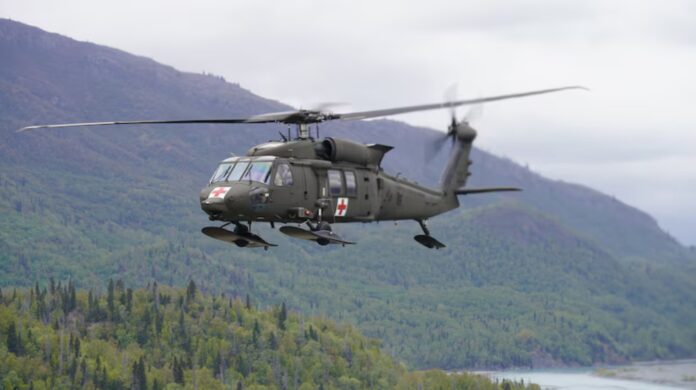Over the course of the busy Memorial Day weekend and into the following week, the Alaska Air and Army National Guard, US Army units, and the Civil Air Patrol responded to six separate emergency missions across the state, working alongside the Alaska State Troopers and local hospitals.
The coordinated efforts from May 24 to 28 resulted in 10 confirmed saves and highlighted the essential role of interagency cooperation in responding to emergencies in Alaska’s rugged terrain.
In the most complex operation of the week, the Alaska Army National Guard rescued five people stranded near the Knik River after their all-terrain vehicle capsized on the shoreline. On May 26, a HH-60M Black Hawk helicopter from Golf Company, 2-211th General Support Aviation Battalion was dispatched with a flight paramedic team and a crew chief, and Chief Warrant Officers Bradley Jorgensen and Mike Miller at the controls.
A good Samaritan had alerted the Alaska State Troopers, who then worked with the Rescue Coordination Center to relay the coordinates of the stranded individuals. One person had sustained injuries during the incident and received immediate care before being airlifted by stretcher. All five were transported to Mat-Su Regional Medical Center for further evaluation.
“We had great coordination with the RCC, and our guys did a great job,” said Jorgensen. “For everyone exploring Alaska this summer, I’d say have a plan and a [satellite communication device].”
The week’s rescue operations started with a May 24 mission in the Seward area, where a hiker injured on a trail was medevaced by an HH-60 Pave Hawk helicopter from the Alaska Air National Guard’s 210th Rescue Squadron. Pararescuemen from the 212th Rescue Squadron supported the mission, working with Seward Fire Department to ensure a successful extraction and one life saved.
On May 25, the Army’s 1st Battalion, 52nd Aviation Regiment responded to a call from Healy Lake, where a patient required emergency transport to Fairbanks Memorial Hospital. Due to weather and terrain challenges, civilian air ambulances were unable to access the area, prompting military intervention. The Army UH-60 crew completed the medevac successfully, marking another save.
The same day as the Knik River operation, a separate joint mission involving the Alaska Army National Guard and Civil Air Patrol was launched to search for an overdue hiker near Sutton. Though the hiker was eventually located by a good Samaritan, the aerial search contributed to the overall recovery.
Later on May 26, the Alaska Air National Guard conducted two separate medevacs. One involved the airlift of an individual with a head injury from a remote cabin near Montana Creek to Providence Alaska Medical Center. Another began on May 27, as crews responded to a leg injury at a remote lodge. The patient was flown to Gulkana, where they were transferred to a civilian air ambulance.
Each of those missions resulted in one additional save, bringing the total number of individuals rescued to ten.
“This busy week was a testament to our capabilities across the state to help Alaskans in need,” said Lt. Col. Aaron Hunter, director of the Alaska Rescue Coordination Center. “As this rescue season kicks off, we encourage all Alaskans to travel with satellite communication devices at all times to ensure their safety.”

What did people do before there was this type of rescue service?
I’ll tell you: They used their heads, planned ahead and were far more careful. Oh, and not smoking dope all the time helped, too.
Back in the day (assuming they weren’t drunk) they often died without rescue. Is that better?
Or are you just old man yelling at the sky?
I don’t know who would be the judge of circumstances but I am in the group that believes reckless behaviour that necessitates a rescue should be liable for cost of said rescue.
Forgot to post the most dramatic one of all:
.
Alaska State Trooper jumped into the freezing Tanana River in Nenana to rescue a near unconscious man hanging for dear life on the river wall, with river current at about four miles per hour. Both Trooper and victim lived.
Unbelievable!
Howdy AST. It would be nice to know his name. That situation was truly, one, where he put his own life at risk, especially someone who is too week to help. Once your in the current, your pretty much a.gonner. Nobody is stronger than the current. Alaskans are blessed to have such first responders. Let’s do our part by not putting them at risk.
Alaska State Trooper Nathan Hollenbeck. He backed up his patrol vehicle to the river wall, tied a rope sling to the vehicle, then to himself, and jumped on the water. Smart Trooper. And he had one unnamed good Samaritan help him save the victim. Trooper and victim both had to go the hospital for exposure treatment. Both lived. Another hero trooper and worth a full article here at MRAK.
He is definitely a hero. Like to see him get a recognition ceremony at the governor’s mansion. All the Air Guard, Troopers, and good Samaritans mentioned in the article, and many others like them, should make us proud to be Alaskans. Thanks for the article, Suzanne.
👍👍
What remote lodge was the leg injury from?